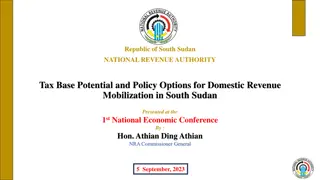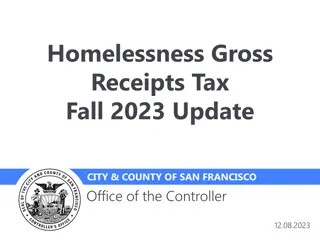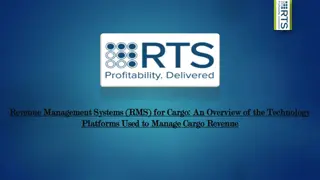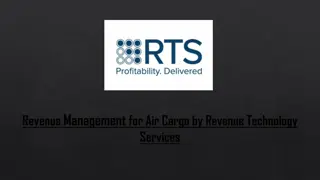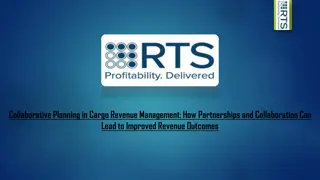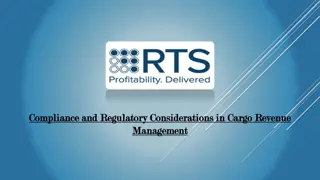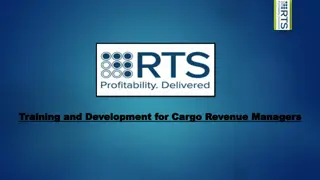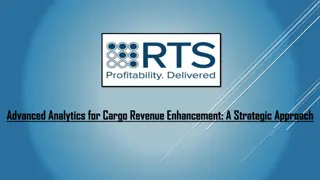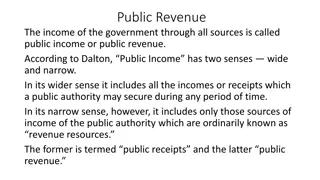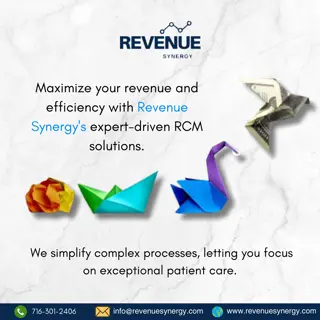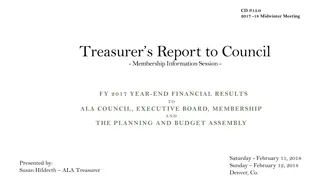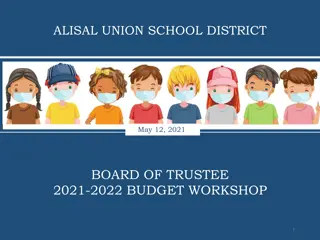Maximizing Revenue Cycle Efficiency in Medical Practice
Explore key performance indicators (KPIs) for revenue cycle management in medical practice. Learn about best practices for optimizing revenue cycle operations, utilizing tools and resources, and analyzing KPI trends over time to enhance organizational performance and financial outcomes.
Download Presentation

Please find below an Image/Link to download the presentation.
The content on the website is provided AS IS for your information and personal use only. It may not be sold, licensed, or shared on other websites without obtaining consent from the author.If you encounter any issues during the download, it is possible that the publisher has removed the file from their server.
You are allowed to download the files provided on this website for personal or commercial use, subject to the condition that they are used lawfully. All files are the property of their respective owners.
The content on the website is provided AS IS for your information and personal use only. It may not be sold, licensed, or shared on other websites without obtaining consent from the author.
E N D
Presentation Transcript
The Business of Medicine Key Performance Indicators Revenue Cycle Harris County Medical Society April A. Bellard, MHA Director of Payment Advocacy and Practice Management
Disclosure 2 Please note the content provided herein is informational Please note the content provided herein is informational only, and should NOT, in any way, be considered legal, only, and should NOT, in any way, be considered legal, professional, business, practice, or other advice. Consult professional, business, practice, or other advice. Consult your own practice adviser or attorney before taking any your own practice adviser or attorney before taking any action or inaction based on this information. action or inaction based on this information.
Best Practices 3 Best practices promote efficiencies without sacrificing quality or outcomes. It is a technique or methodology that, through experience and research, has proven to reliably lead to a desired result. The three main barriers to adoption of a best practice are: a lack of knowledge about current best practices a lack of motivation to make changes involved in their adoption a lack of knowledge and skills required to do so
RCM Key Performance Indicators 5 Revenue cycle management (RCM) key performance indicators (KPI) measure the viability and productivity of the RCM process. They present a visual and easy-to-digest means of analyzing operations. Tracking your organization s performance can help you improve services and revenue and give you a greater understanding of your operations. Additionally, they help bring transparency and accountability and are a useful data visualization tool that helps you build a better understanding of your operations on a more granular level. The data needed to analyze KPIs should be readily available in your practice management system s report function. Familiarize yourself with your system s reporting functions as it already may provide many of these KPIs for you. Run KPIs on a schedule and keep a running chart to identify trends over time.
Tools and Resources - Key Performance Indicators https://bit.ly/2rHkPrE 6
Tools and Resources - Key Performance Indicators https://bit.ly/2rHkPrE 7
Tools and Resources - Key Performance Indicators https://bit.ly/2rHkPrE 9
Gross Collections Ratio 10 Compares the dollars collected from dollars billed to determine how much is received from your gross charges. Use data from 4-6 months back to ensure claims had sufficient time to pay. High ratios indicate your fee schedule may be too low Low ratios may indicate your fee schedule may be too high, poor collections, unfavorable contracted rates, unbalanced payor mix, coding inaccuracy Important: Identify payments that equal 100% of billed charges. This may indicate the fee schedule is set too low for those codes and needs to be updated. Fee schedules must have a methodology. Set your fee schedule at a reasonable rate; Generally family practices average 150-200% above Medicare while specialty practices average 300% above Medicare. You want to set a rate that doesn t overstate your costs but is high enough that you don t leave money on the table by billing less than your contracted rate. Total Collections - Overpayments Total Gross Charges = Gross Collections Ratio Gross charges: $600,000 Overpayments: $5,000 Collections: $65,000 ($65,000-$5,000)/$600,000 = 10%
Net Collections Ratio 11 This ratio indicates the percentage of the contracted rate (allowed amount) that has been collected. Ideally, you want this ratio to be at 100%, but a net collection rate of 95% or above is an industry average. Use data from 4-6 months back to ensure claims had sufficient time to pay and appeals finalized. Low ratios may indicate: Excessive denials lack of preauth/referral, no insurance verification, incorrect coding, etc. Inappropriate adjustments Denials are not appealed or appeals are unsuccessful Poor collection efforts Inappropriate adjustments Make sure adjustment reasons are accurate. Failing to distinguish between noncontractual adjustments and contractual adjustments results in a misleading view of how well your practice collects the amounts owed by payers. Categorizing noncontractual adjustments (e.g. past filing deadline, preauthorization not obtained, medical necessity, bad debt, etc.) will help reveal sources of errors that need to be addressed. If the ratio is low, run the calculation by payer to determine if the problem stems from a particular payer. Also run by CPT code to determine if the problem is limited to certain procedures. Total Collections - Overpayments Total Contracted Rates = Net Collections Ratio Contracted rates: $75,000 Collections: $65,000 Overpayments: $5,000 ($65,000-$5,000)/$75,000 = 92.3%
Days in Accounts Receivable 12 Measures the average number of days it takes to collect payment. Use data from the past 6 months. The lower the number, the faster a practice is obtaining payment on average. Days in A/R should be below 30 days due to Texas Prompt Pay laws. High A/R days may indicate: Inadequate follow-up on claims Lack of up-front collections and poor collection efforts Problems with benefits/eligibility verification, preauthorizations, improper coding (CPT, modifiers, ICD-10) Poor use of front-end claim edits Total A/R $70,000/$1643.84 = 42.58 days = Days in A/R Average Daily Charges Gross Charges: $600,000 Total A/R: $70,000 Avg. Daily Collections: $600,000/365 = $1643.84
Accounts Receivables Aging 13 Measures the amount and percent of monies owed in each aging bucket (0-30 days, 31-60 days, 61-90 days, 91-120 days, and 120+ days). Both insurance and patient agings should be analyzed.
Accounts Receivables Aging 14 Add back any credit balances as they reduce the total A/R. Run this report monthly to effectively manage the revenue cycle and then compare to past months to identify any notable changes. The most important measure is A/R > 120 days as these dollars are harder to collect. 0-30 A/R + (Credit Balances) TTL A/R + (Credit Balances) 0-30 % of TTL A/R 0-30: (16,7000 100)/36,390 = 46% =
Denial Rate 15 Measures the percentage of claims denied. Strive for 5% or less. High denial rates may be a result of: Improper coding Lax front-end processes (eligibility/benefits, preauth, referrals, etc.) Late filing Failing to met conditions of coverage Calculate within a given period of time far back enough to ensure claims have been processed by payers, and compare with prior like periods to identify trends. Drill down to the payer and code level to isolate the problem as it may be a particular payer or procedure that is the culprit. Work denials as soon as they are received to avoid exceeding appeals deadlines. Make sure you fully understand the denial reason. Follow the payer s appeal process precisely (click on the links to payers on our Billing and Payers page for this information) and specifically address the denial reason in the appeal with supporting documentation highlighted and referenced in the appeal letter. Total Denials Total Claims = Denial Rate Total claims: 100 Total denials: 10 10/100 = 10% Denial Rate
Bad Debt Ratio 16 Measures the dollars owed but uncollected (does not include contractuals or legitimate denials and other write-offs). Calculate for both payers and patients for a given timeframe. Bad debt ratios for insurance should ideally be 0% because the practice should be collecting all allowed amounts. Patient bad debt should be < 5%. Collect at check in all patient responsibilities past and present, and at check-out any other amounts owed due to unforseen treatments or services. Analyze adjustments to reveal improper write-offs or to identify avoidable adjustments. Total Bad Debt Total A/R (after adjustments)= Bad Debt Rate Total A/R Owed: 100 Total Bad Debt: 10 10/100 = 10% Bad Debt Rate
Payer Mix Ratio 17 Measures the percentage each plan contributes to the practice's overall income. Even distribution across payers insulates the practice from the financial impact of losing a contract or changes in census from a payer. If patients from one contracted plan make up the majority of the patient mix but that plan compensates at a lower rate than other contracted plans, consider closing the panel for that payer. Also, if the practice cannot schedule all patients seeking an appointment, consider dropping lower-paying plans to make room on the schedule for higher paying plan patients. Payments by Payor Total Payments of All Payers=Payer Mix Ratio
Billing Lag and Charge Capture Days 18 Billing Lag Days - The number of days from the date of service it takes to file a claim. Run reports to determine the average number of days from the date of service to claim submission for a given period of time (monthly, quarterly, etc.). Average days to file a claim should be < 7 days. A few days lag has a powerful impact on cash flow. File claims daily when possible to ensure prompt reimbursement. Charge Capture Days - The number of days between the date of service to posting of the charges. Run reports to determine the average number of days from date of service to posting date for a given period of time (monthly, quarterly, etc.). Average days to post charges should be 1-2 days. Charges posted late delays claims filing and adversely affects cash flow. Possible causes: Physicians not completing charts on time Charges not posted timely Claims not filed timely Inadequate staffing
HCMS Payment Advocacy Program HCMS Payment Advocacy Program 19 HCMS has been providing payment assistance and working to resolve payer-related issues for many years. Since the inception of the Payment Advocacy Program in 2000, HCMS has collected more than $31,000,000 in improperly paid claims, free of charge, for our physician members.
TMA Free Educational Resources TMA Free Educational Resources 20 As part of your TMA membership, hundreds of CME, ethics hours, and other educational resources are now available at no cost, compliments of TMA Insurance Trust.
Contacts Contacts 21 Rachel Zetino, MBA, MSHA, VP-Business of Medicine and Operations rachel_zetino@hcms.org April Bellard, MHA, Director Payment Advocacy & Practice Management april_bellard@hcms.org



